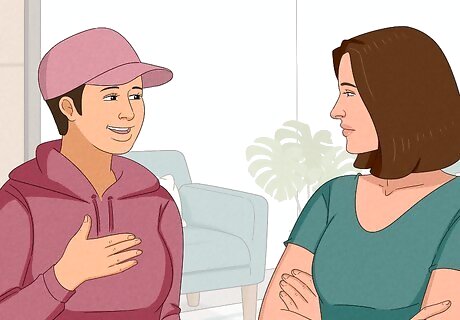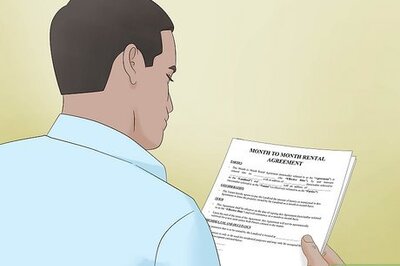
views
- Approach the person privately and bring up their passive-aggressive behavior. Stay calm and use I-statements to express yourself.
- Set boundaries to protect yourself from passive-aggressive people. Follow through with consequences if they don't respect your boundaries.
- Get help from a mediator or avoid them in the future (if possible) if they refuse to stop being passive-aggressive toward you.
Dealing with Passive-Aggressive People

Start a conversation about the issue as soon as possible. It can be tempting to sweep passive-aggressive behavior under the rug—but the best way to respond to passive-aggressive behavior is to address it sooner rather than later. Expert psychotherapist Stefanie Barthmare stresses the importance of starting the conversation by explaining in your own words what seems to be happening as directly and specifically as you can. For example, you might say, “I may be wrong, but it seems like you’re upset that David wasn’t invited to the party. Do you want to talk about it?” Passive aggressive people might try to twist your words with technicalities if you’re vague or talking in generalizations, which is why it’s so important to be direct, according to Barthmare. For example, generalizing and saying, “You’re always this way!” isn’t very productive. Say someone keeps giving you the silent treatment, and it bothers you; in that case, explain a specific incident where they did so.

Express how their behavior is making you feel using “I” statements. Focusing on how you feel makes it easier to discuss the problem without sounding like you’re attacking the other person. “I” statements (like “I felt bad after you slammed the door because it felt like you didn’t want to listen to me”) emphasize your emotions, whereas “You” statements (like, “You’re so rude”) imply blame and judgment. For example, you could say, "When you speak in such a curt way, it makes me feel hurt and dismissed." This way, they have to acknowledge the effect their behavior is having on you. Passive-aggressive people tend to beat around the bush. Don’t beat around the bush back at them! Let them know how you feel without sugarcoating it or being overly harsh.

Create a safe space for them and offer to solve the issue. It can be tough to admit when something is upsetting you—so try to make it a little easier for the passive-aggressive person to acknowledge their feelings. Whether you’re addressing a friend, coworker, or subordinate, tell them that it’s safe to come to you with issues and that you’d rather they speak openly about their concerns. Try gently letting them know that you can sense something’s wrong. For example, you might say, “You seem pretty upset right now,” or “I feel like something is bothering you. I’d like to help if I can.” Make it clear that you want to solve the problem together as a team. This can show the passive-aggressive person that you’re listening to them—and that you care.

Use clear and assertive (yet respectful) communication. According to expert psychologist Catherine Boswell, assertive communication simply means being confident, nonreactive, and respectful. Be as objective and direct as possible when communicating with them—and remember to listen to them, too. Consider and acknowledge their point of view, validating their feelings even if you think they’re wrong. There’s aggressive, passive, and passive aggressive communication—but none are as effective as assertive communication.

Stay calm and avoid responding passive-aggressively. If you’re upset, take time to calm down before addressing the issue. Take a walk, crank up your favorite song and dance, do a crossword, or find some other activity that relaxes you. Then, figure out exactly what you need from the situation—such as what kind of outcome seems reasonable and acceptable to you. If you let them get a rise out of you, it might reinforce the idea that their passive-aggressive behavior works—and they might keep doing it. Resist the urge to act on reflexive anger or emotionally charged reaction. You'll appear much more in control and will come across as someone they can’t push around.

Use positivity to defuse any tension. Sincere kindness is one of the most effective and disarming weapons against passive-aggressive people. They may draw you into their vortex of negativity, acting out without getting blamed for it—so, to fight back, simply don’t sink to their level. Be positive and pleasant. If the situation calls for it, try cracking a lighthearted joke, too. Avoid name-calling, shouting, or overt anger. According to psychologist Catherine Boswell, if you stay positive, you’ll be in a better position to keep the focus on their actions, not yours. Getting angry can divert attention from the real problem. Model positive behavior, whether you’re dealing with children or adults. Show them how to interact with you by addressing your own concerns and emotions directly. Humor can keep a conversation positive. A passive-aggressive person might get defensive when you point out their behavior, but with a little humor, they might relax and realize you're not attacking them.

Figure out what might be causing the passive aggression. Passive-aggressive people tend to say they’re “fine” or that nothing is wrong, even when that’s not true. So, if you feel like a passive-aggressive person is doing this, don’t let it go—ask deeper questions to try and find the source of the problem. Let them know that you want to understand how they feel, and give them a chance to explain themselves. If this person is one who doesn't typically show anger, talk to someone who knows what upsets them—and what subtle signs they might give when angry. Remember: passive-aggressive behavior is usually a symptom of another cause. People rarely act out without a reason!

Set clear standards and limits with the passive-aggressive person. By establishing boundaries with a passive-aggressive person, you’re letting them know exactly what you need from them and what behavior you consider unacceptable, making it easier to hold them accountable. Tell them what you need from them going forward and what you plan to do if the passive-aggressive behavior continues. For example, if you’re dealing with a coworker, you might say that you’ll have to report them to a supervisor if they keep giving you the silent treatment and refusing to cooperate. Similarly, if you’re a supervisor, you might tell an employee exactly what you expect from them on a project that they’ve been passive-aggressively putting off. Remember, it’s your right to set boundaries. You don’t have to let a passive-aggressive person walk all over you! At its roots, passive-aggressive behavior is a power struggle. Being too lenient might make them think they can keep doing it—so be firm about what behavior you will and won’t tolerate.

Enforce consistent consequences for passive-aggressive behavior. Once you tell a passive-aggressive person the consequences of their continued bad behavior, always follow through on your words. Show them you’re willing to back up your words with actions! They’ll be more motivated to change their behavior and be more cooperative with consistent consequences. Asserting consequences is one of the most powerful you can "shut down" a passive-aggressive person, and it’s just as important as setting those consequences in the first place. Passive-aggressive people tend to put up resistance when confronted on their behavior. They might be in denial, make excuses, or point the blame elsewhere. However, with clear boundaries, they won’t have anywhere to turn. They’ll have to adjust their behavior or live with the consequences.

Reinforce appropriate (or good) behavior. In behavioral psychology, you can give a person “reinforcement” after they perform a certain behavior to try and get them to act that way more often. Positive reinforcement means rewarding the behavior you want to see. So, watch for good behavior (such as stating their needs or concerns directly) and take every opportunity to reinforce it. For example, when a passive-aggressive person is open and honest about their feelings (“I feel like you’re being mean to me on purpose!”), that’s actually a good thing! Reinforce this behavior by saying something like, “Thank you for telling me how you feel. I really appreciate when you do that.” This draws positive attention to their openness, helping them see that communicating their feelings is something they can (and should) do.

Find common ground with them. By finding common ground with a passive-aggressive person, you can reduce the tension between you. Common ground between two people (such as shared goals, values, interests, or beliefs) can create a stronger rapport—and if they feel a connection with you, they might be more open to cooperating instead of acting passive-aggressively. For example, say your friend’s roommate is sending passive-aggressive signals. You might try to get to know them better and ask about their interests to see what you have in common! Similarly, you might talk to a passive-aggressive coworker and see if you have any shared ideas on how to handle a project.

Get help from a mediator or arbitrator. This person should be an objective third party, whether it’s an HR representative, a family member, or even a mutual friend. The idea is to use someone the passive-aggressive person can also trust! Before meeting, give the mediator a list of your concerns. Then, once in the meeting, be open-minded and try to see things from the other person’s point of view. When you confront a passive-aggressive person yourself, you might hear excuses like, "Relax, it was a joke" or "You take things too seriously." Thus, having a third-party mediator can work better, as they can help direct the conversation and encourage more honest discussions.

Keep your distance from them if the behavior doesn’t change. When someone is passive-aggressive toward you on a regular basis, and no amount of intervention stops them from doing it, it’s perfectly reasonable to avoid them. Don’t be afraid to put your well-being first! If you have to see them (at work, or with mutual friends, for example), limit the amount of time you spend with them. For example, you might resolve to only interact with them when you’re in groups—no one-on-one conversations. Try not to give them any information they can use against you, either. Even if they ask questions, try to keep things vague and brief. Avoid sharing any personal information (including emotions or thoughts).
What is passive-aggressive behavior?

Passive aggression is a pattern of indirectly expressing negative feelings. Rather than discussing and dealing with problems openly, passive-aggressive people hide their frustration and express it covertly. As a result, passive-aggressive behavior can be hard to spot. There's often a disconnect between what passive-aggressive people say and do. Passive-aggressive people may be insecure, afraid of losing control, coping with stress, anxiety, or depression, or trying to deal with a conflict. They also might simply be acting out over a grudge. Passive-aggressive people often were encouraged to mask their feelings from an early age (rather than being open about them). Thus, they learn to use passive aggression instead of tackling issues directly.

Passive aggression can harm personal and professional relationships. It may seem annoying initially, but it can also have serious effects; between friends and family members, passive aggression can create long-lasting conflict—and in the workplace, it can even impact the quality of your work. After all, if someone on a team is passive-aggressive, they might withhold information or fail to get their tasks done. Ultimately, passive-aggressive behavior is unhealthy and unproductive no matter where or when it’s used. For example, if a passive-aggressive coworker is assigned a task, they might do a lackluster job out of spite, which reflects badly on the whole team.
Signs of Passive Aggressive Behavior

Passive aggressive behavior is generally subtle or underhanded. It’s insidious because the person doing it has plausible deniability. When confronted, they may be defensive and refuse to acknowledge what you’re talking about, according to psychologist Catherine Boswell. Nonetheless, telltale signs of passive aggression include: Resentful agreement: They might say, “I’m fine,” or “Okay, you win,” but seem sulky and annoyed afterward. You may find yourself feeling tired or deflated after spending lots of energy trying to deal with them. Sarcasm: They might make rude, sarcastic quips or jokes to offend you indirectly. Feeling hurt from being on the receiving end of passive-aggressive behavior is also normal. Criticism: They might criticize every little thing you do because they’re quietly upset about something. Blame: It’s also rare for a passive-aggressive person to take responsibility for their actions; they’re more likely to blame problems on others. Mumbling: You might see them mutter the things they don’t want to say out loud under their breath. Silent treatment: They might just cut off all contact, refusing to speak to or acknowledge you (even if they said they weren’t angry). Pretending to cooperate: They might tell you they’ll do something and then fail to follow through to spite you, or they’ll do the task poorly. Withholding affection: They might avoid eye contact or brush off any efforts to connect, either emotionally or physically. Complaining: They might complain about being underappreciated or being asked to do too much if they're being passive-aggressive.



















Comments
0 comment